Hand Warmup Exercises: Boost Mobility and Fine Motor Skills Fast
Updated On: October 24, 2025 by Aaron Connolly
Essential Hand Warmup Exercises
Let’s get right into it. These three simple exercises really wake up the key muscle groups in your hands and fingers.
They’ll get you ready for long gaming sessions, help reduce strain, and give your grip some extra control.
Hand Squeezes
Hand squeezes are all about grip strength. They warm up the muscles in your palms and fingers, and honestly, they’re a lifesaver if you want to avoid fatigue during marathon gaming.
Basic Hand Squeeze Technique:
- Make a tight fist with both hands.
- Squeeze hard for 5-10 seconds.
- Open up and spread your fingers wide.
- Do this 8-10 times.
Advanced Variation:
- Grab a stress ball or grip strengthener.
- Squeeze and hold for 10-15 seconds.
- Focus on steady pressure, not speed.
Start with the basics before you reach for gear. Your hands should feel warm, not sore. If you get any sharp pain, stop right away.
Benefits for gamers:
- Builds grip strength for controllers.
- Cuts down on hand cramps.
- Boosts blood flow to fingers.
Finger Push-Ups
Finger push-ups work those tiny muscles between your fingers. They’re great for building up individual finger strength, especially when you need precise movements.
Wall Finger Push-Ups:
- Stand about an arm’s length from a wall.
- Put your fingertips on the wall at shoulder height.
- Keep fingers straight and lean in, pushing yourself toward the wall.
- Push back to where you started.
- Do 5-8 reps.
Table Finger Push-Ups:
- Put your fingertips on a table edge.
- Lean forward a bit.
- Push down with your fingertips.
- Hold it for 3-5 seconds.
Try wall push-ups first, then move to the table. These build the fine control you need for gaming gear.
They also help keep your fingers from getting stiff during long sessions.
Palm and Back Rubbing
Palm and back rubbing is an old-school trick that works. You’ll generate heat, boost circulation, and get your hands feeling flexible in no time.
Proper Rubbing Technique:
- Rub your palms together hard for 10-15 seconds.
- Put one palm on the back of your other hand.
- Rub in circles for 10 seconds.
- Switch hands and repeat.
- Interlace your fingers and gently rotate your wrists.
Temperature Benefits:
- Your skin temperature goes up by 2-3 degrees.
- Blood flows better to your fingertips.
- Joints feel less stiff.
I’d suggest starting your warmup with this one. That heat really preps your hands for tougher exercises.
If you’re gaming for hours, repeat this every so often to keep your hands loose.
Quick Circulation Boost:
- Shake out your hands for 5 seconds.
- Wiggle each finger.
- Rotate your wrists both ways.
Finger Mobility and Dexterity Drills
These drills are all about finger independence, coordination, and fine motor skills.
Practicing them regularly makes your fingers stronger and more controlled for those clutch in-game moves.
Finger Isolation Movements
Finger isolation exercises teach each finger to move on its own. That’s the foundation for better finger control and dexterity.
Basic Finger Lifts
Put your hand flat on a table, palm down. Start with your thumb and slowly lift each finger, one at a time.
Hold each finger up for 2-3 seconds, then lower it.
Press the other fingers down to the table so you’re not cheating. It’s harder than it sounds!
Individual Finger Presses
Press one fingertip down onto the table, keeping the others lifted. Go through each finger in order: thumb, index, middle, ring, pinky.
Take it slow at first. Don’t rush—clean movement is more important than speed.
Finger Waves
Lift your fingers in a wave from thumb to pinky, then back again. Try to keep it smooth, no jerky movements.
Do this for 30-60 seconds per hand. Take breaks so you don’t get too tired.
Piano Fingers Technique
The piano fingers drill feels a little silly, but it works. You’ll tap your fingertips like you’re playing piano keys, which is perfect for building finger independence.
Basic Piano Tapping
Tap your fingertips on a flat surface, thumb to pinky (1-2-3-4-5).
Keep your wrists relaxed and your fingers naturally curved. Don’t flatten them out.
Advanced Patterns
Mix it up with patterns like 1-3-5-2-4 or reverse from pinky to thumb. Try to keep your timing steady.
Speed Building
Start slow with clear taps. Once you’re comfortable, speed up, but don’t lose finger independence.
Practice for 2-3 minutes. If your fingers get tired or sloppy, take a break.
Both Hands Together
Once you’re good with one hand, try both. Start with mirroring the movements, then alternate between hands.
Inchworm Exercise
The inchworm drill makes your fingers more flexible and strengthens those tiny hand muscles. It’s a bit quirky but surprisingly effective.
Setup Position
Put your fingertips on a flat surface, palm lifted just a bit. Your fingers should arch over the table.
The Movement
Keep your fingertips down and move your palm forward by “walking” your fingers. Then stretch your fingers forward while your palm stays put.
You’ll look a bit like an inchworm, inching along.
Progressive Distance
Start by moving just a few centimeters. As you get better, go for longer distances.
Reverse Direction
Try the movement backwards to work different muscles. It’s a good way to shake things up.
Do 5-10 steps each way. Rest between rounds to avoid cramps.
Bilateral Coordination Exercise Routines
Warming up both hands together is huge for gaming precision and endurance. These exercises train symmetrical movements and hand positioning, making your bilateral coordination sharper.
Both Hands Fingers Crossed
This one’s about getting your hands to sync up, even with different finger positions.
Put both hands flat on your desk. Cross your index finger over your middle finger on both hands at the same time.
Hold for 5 seconds, then uncross.
Try alternating: cross fingers on your right hand, keep your left flat. Switch every 3 seconds for 30 reps.
Advanced variation: Cross different finger pairs on each hand. For example, index-over-middle on your right, ring-over-pinky on your left.
This exercise really wakes up both sides of your brain. Plenty of esports players swear by it as a pre-match warm-up.
Simultaneous Hand Movements
These get your hands ready for moves like WASD plus mouse control.
Hold your hands out, palms down. Make clockwise circles with your right hand and counter-clockwise with your left, both at the same time.
Do 10 rotations each way.
Quick win: Go slow at first. Your brain might trip up on the opposing motions.
Try the classic “pat and rub.” Pat your head with your right hand and rub your stomach in circles with your left. Switch after 15 seconds.
For a gaming twist, tap your right index finger and left pinky at the same time. Swap which fingers you use every 10 taps.
Chair Push-Ups
Chair push-ups build bilateral coordination and core stability—super useful for long gaming sessions.
Place both hands on your chair’s armrests or the seat edge. Make sure your hands are even.
Push yourself up a bit, using both arms equally.
Hold for 3-5 seconds, keeping the pressure balanced. Lower yourself slowly, using both arms.
Heads up: Don’t let your strong arm do all the work. Focus on matching the effort.
Do 8-12 reps, aiming for even movement. Your weaker side will catch up over time.
This move helps you keep good posture and reinforces coordinated patterns for gaming.
Shoulder and Arm Warmups for Hand Readiness
Your shoulders and arms set the stage for your hands. These three exercises boost blood flow up top and get your hands primed for accuracy.
Shoulder Shrugs
Shoulder shrugs are probably the easiest way to wake up your shoulders before you game.
Start with the basics to get blood moving.
How to perform shoulder shrugs:
- Sit up straight in your chair.
- Lift both shoulders toward your ears.
- Hold for 3-5 seconds.
- Lower slowly.
- Repeat 10-15 times.
Move slow and steady. Don’t rush or strain your neck.
Benefits for gamers:
- Relieves shoulder tension from hunching forward.
- Improves blood flow to your arms and hands.
- Takes barely half a minute.
Try pairing shrugs with deep breaths. Inhale as you lift, exhale as you lower.
Desk Push-Ups
Desk push-ups fire up your chest, shoulders, and arms—no floor space needed. They get your upper body ready for long sessions and help strengthen your arms.
Proper desk push-up technique:
- Stand an arm’s length from your desk.
- Place your palms flat on the desk edge, shoulder-width apart.
- Keep your body straight.
- Lower your chest toward the desk.
- Push back up.
- Do 8-12 reps.
Make sure your desk is solid. If it feels shaky, use a wall.
Why desk push-ups help gamers:
- Strengthen arms for better mouse control.
- Improve shoulder stability.
- Help fix forward head posture.
- Don’t need any special gear.
If these are tough, move your feet closer to the desk to make them easier.
Crocodile Snaps
Crocodile snaps get your shoulders and chest moving with a bit of fun. You’ll mimic a crocodile’s jaw opening and closing—using your arms, of course.
How to do crocodile snaps:
- Stand with feet shoulder-width apart.
- Stretch your arms out to the sides at shoulder height.
- Bring your arms together in front of your chest.
- Cross one arm over the other.
- Open back up.
- Do 15-20 reps, switching which arm crosses on top.
Keep the movement controlled and smooth. You should feel a stretch across your chest.
Gaming benefits:
- Loosens up your shoulders.
- Stretches chest muscles that get tight from keyboard use.
- Boosts circulation to hands and fingers.
- Takes less than a minute.
Try crocodile snaps between matches or during load screens. They’re a quick way to reset your body during long play sessions.
Wrist Flexibility and Stretch Techniques
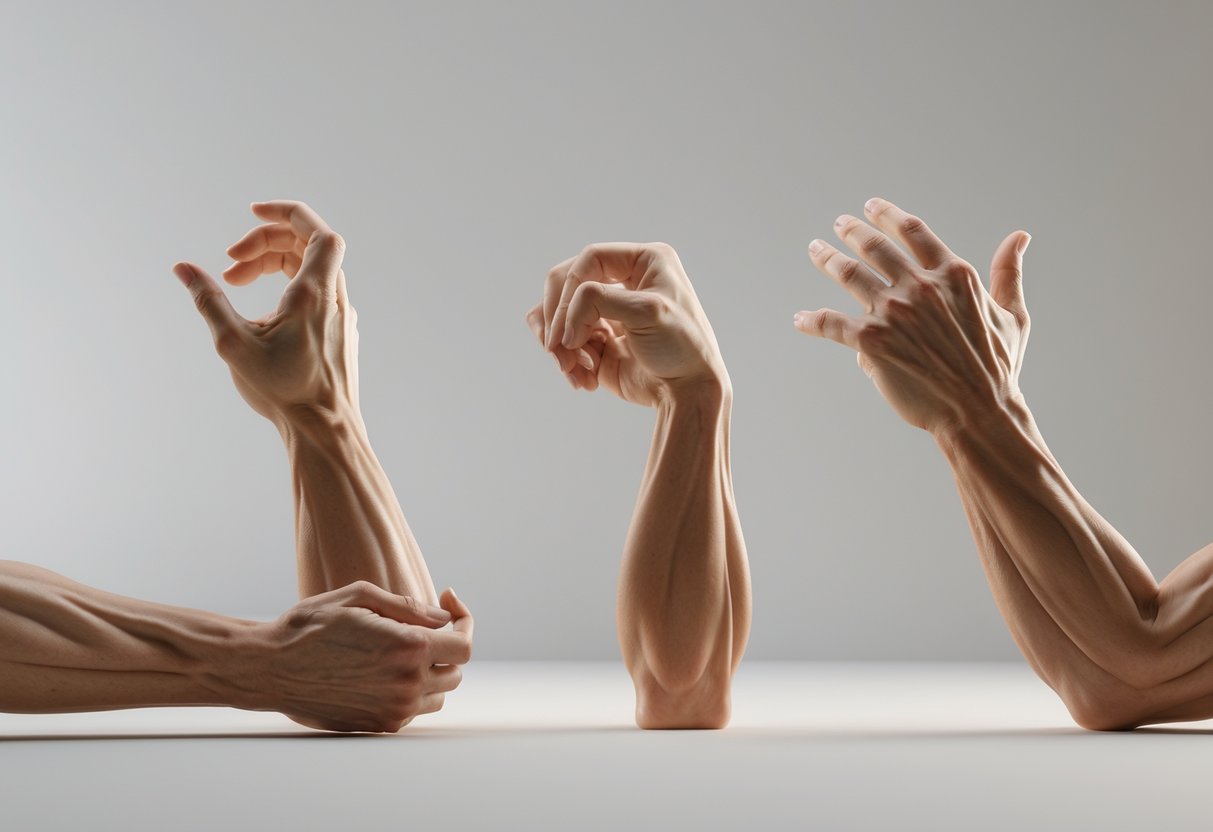
Controlled flexion movements target the muscles and tendons in your wrists. Add circular rotations to boost joint mobility. These basics get your wrists ready for long gaming sessions and help cut down on strain.
Wrist Flexion Movements
Flexion stretches the muscles on both sides of your wrist. Start simple: move your wrists up and down to wake up those key areas.
Prayer Position Stretch
Press your palms together in front of your chest. Lower your hands toward your waist but keep your palms pressed. When you feel a gentle stretch, hold for 5-7 seconds.
Reverse Prayer
Put the backs of your hands together, fingers pointing down. This stretch hits the opposite muscles from the standard prayer pose.
Individual Finger Extensions
Hold one arm out, palm up. With your other hand, gently pull each finger back, one at a time. Hold each finger for about 10 seconds.
Move slowly through these. If you feel pain, stop right away. Aim for a light stretch, not discomfort.
Circular Wrist Rotations
Rotational exercises move your joints in every direction. These help you keep the flexibility you need for sharp mouse movements.
Basic Wrist Circles
Extend your arms and make slow circles with your wrists. Do 5 circles one way, then 5 the other. Keep it smooth and controlled.
Windscreen Wiper Motion
Rest your forearm on the desk, palm down. Slide your hand side to side, like a windscreen wiper, without lifting your wrist. Pause for 3-5 seconds at each side.
Resistance Rotations
Make a loose fist. Use your other hand to add gentle resistance as you rotate your wrist. This builds strength and flexibility at the same time.
Try these rotations at the start and end of your gaming sessions for best results.
Grip Strengthening Strategies
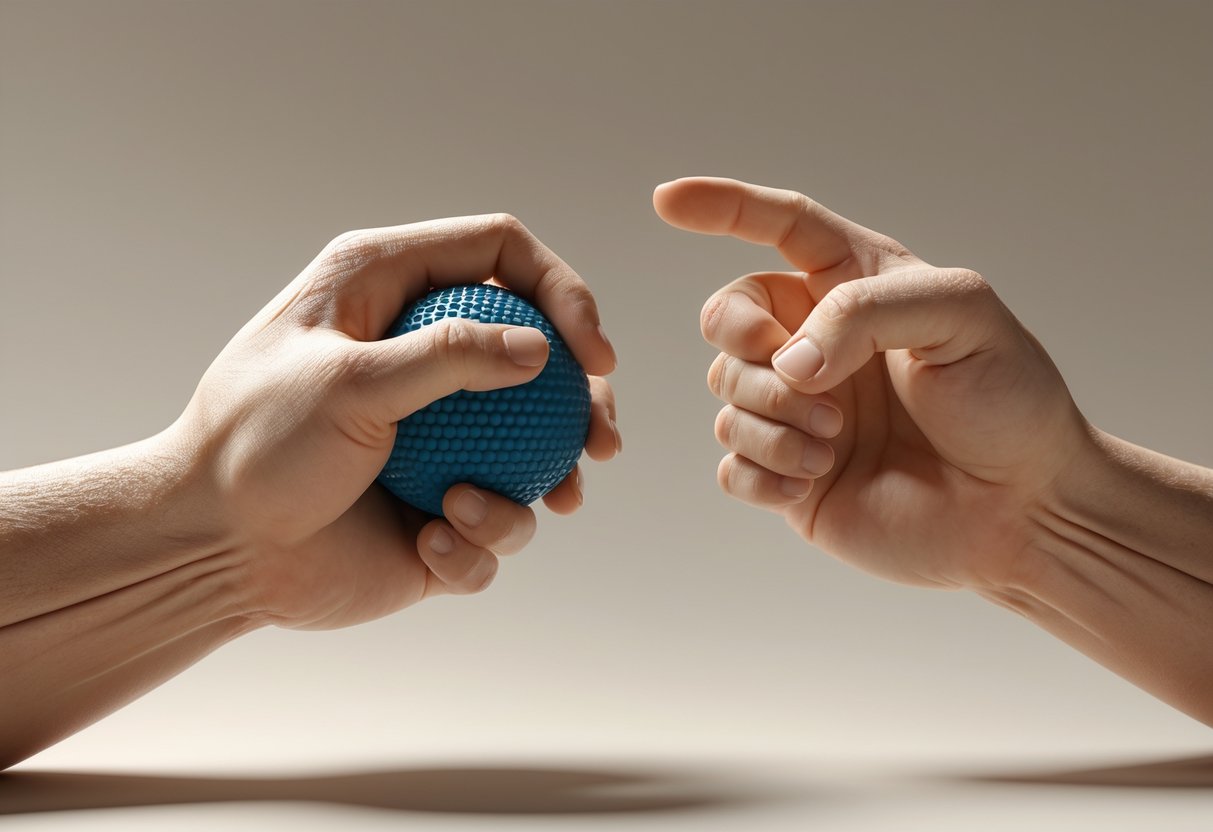
Regular grip strengthening keeps your hands safe from injury and boosts your finger dexterity. These exercises hit different muscle groups in your hands and forearms, building your grip power over time.
Stress Ball Squeezes
You can build grip strength fast with stress ball exercises. They’re simple, portable, and work all those tiny hand muscles.
Grab a medium-resistance stress ball. Squeeze it as hard as you can for 5 seconds, then slowly release. Repeat 10 times per hand.
Progressive Training Schedule:
- Week 1-2: 10 squeezes, 3 times a day
- Week 3-4: 15 squeezes, 3 times a day
- Week 5+: 20 squeezes or switch to a firmer ball
Mix it up with rapid squeezes for 30 seconds, then do some slow, controlled ones.
You can also try finger-specific squeezes. Just press your thumb and index finger into the ball, hold for 3 seconds, then switch to the next pair.
Playdough Rolling Activities
Playdough isn’t just for kids—it works your fingers in ways gaming doesn’t. The resistance helps those smaller muscles that support your grip during long sessions.
Roll playdough into a ball, then squash it flat with your palm. That gets your whole hand and wrist moving.
Try rolling skinny playdough snakes with just your fingertips. Go as thin as you can for a real finger workout.
Finger Strengthening Routine:
- Pinch small pieces off (30 seconds per hand)
- Roll thin snakes with fingertips (1 minute per hand)
- Press each finger deep into the dough (10 presses per finger)
You can do these while watching streams or between matches. Just keep a small tub of playdough at your desk.
Fun and Creative Warmup Activities
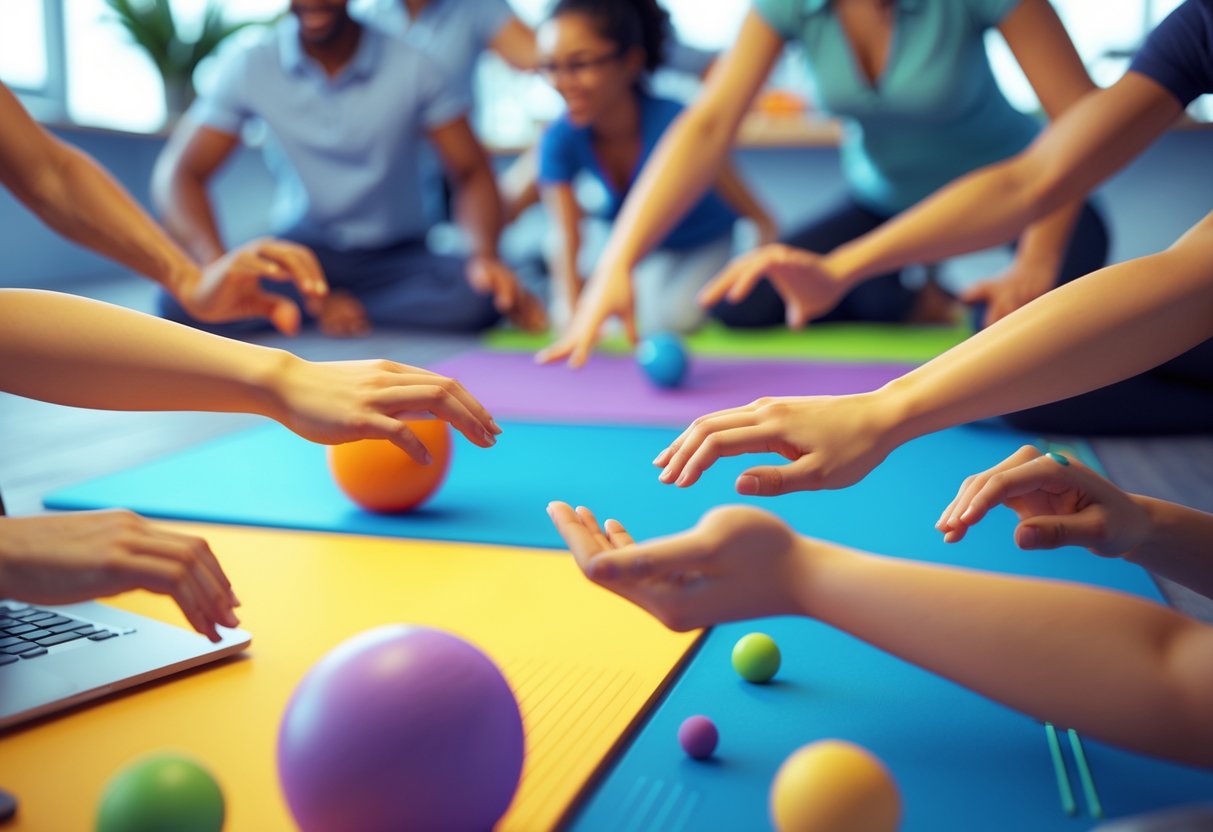
Games and playful exercises make hand warmups more interesting. They build finger strength and dexterity for gaming, but honestly, they just feel less like work.
Pick Up Sticks Game
Pick up sticks turns hand prep into a challenge. You can buy a set or just use some wooden skewers.
The game makes you use precise finger control and steady hands. You need to lift sticks one by one without shifting the pile.
Benefits for gamers:
- Sharpens fine motor skills
- Boosts finger independence
- Builds steadiness
- Improves visual-motor coordination
Drop 20-30 sticks in a pile. Use your thumb and forefinger to pick up one at a time. Focus on moving slow and steady, not fast.
Progression tips:
- Start with thicker sticks, move to thinner ones
- Switch up which fingers you use
- Try picking up specific colors first
The precision and resistance feel a lot like gaming. Your fingers warm up and your brain gets a little strategic workout, too.
Finger Puppet Play
Finger puppets make warmups way more entertaining. Each finger moves on its own, following simple patterns.
Buy some puppets or make your own with paper and tape. Just make sure every finger has its own character.
Simple puppet exercises:
- Make each puppet “dance” by flexing fingers
- Have puppets “talk” by moving them toward each other
- Create little stories that use different finger sequences
This really helps if you need independent finger control for gaming. Each finger learns to move on its own but still work with the others.
Advanced variations:
- Use puppets on both hands at once
- Follow along with music or rhythm
- Practice key combos for games
It keeps things fun, so you don’t zone out during warmups. Your hands get ready for gaming without it feeling like a chore.
Proprioceptive and Tactile Warmups
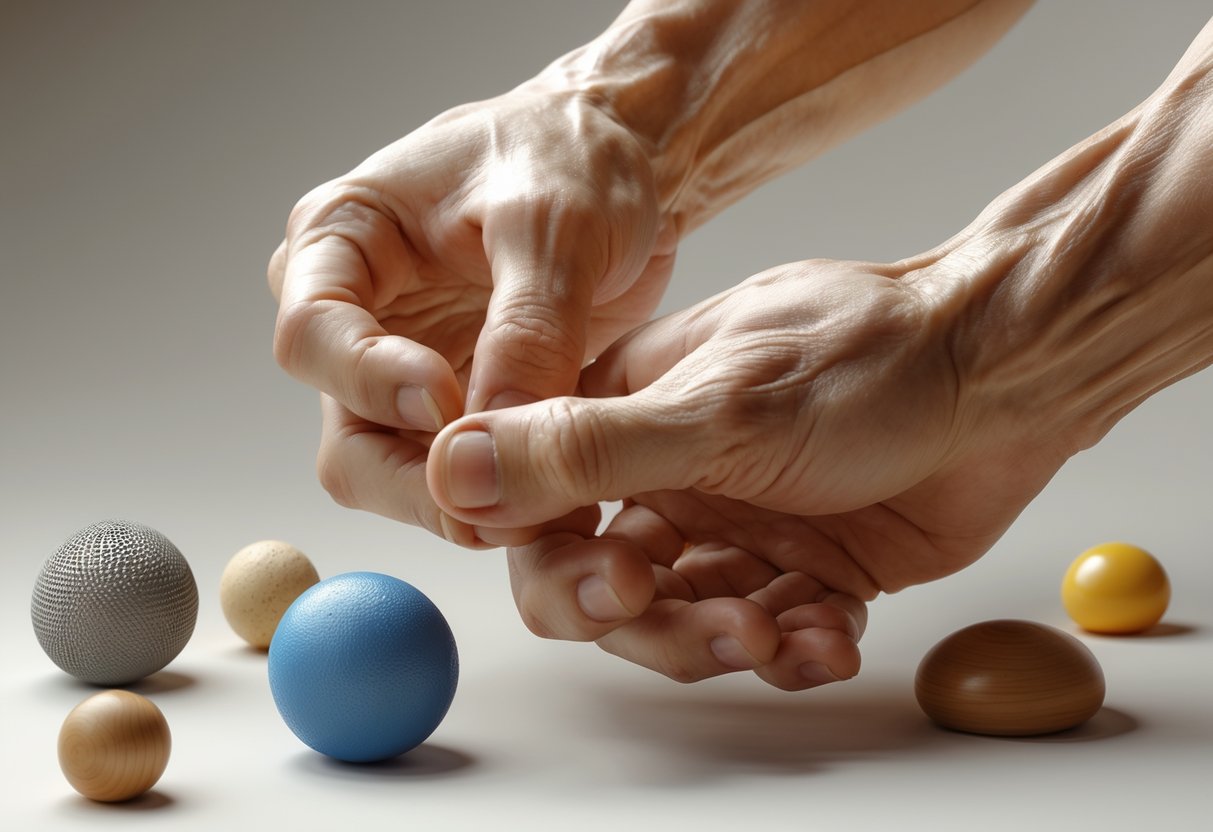
These exercises help your hands figure out where they are and how things feel. They prep your muscles and nerves for precise moves by sending strong signals to your brain about hand position and touch.
Imaginary Glove Application
Pretend you’re putting on tight gloves. Rub your palms together for about 15-20 seconds to warm them up.
Press your fingertips together and hold for 10 seconds. This helps your brain map out each finger.
Now, make fists and squeeze hard for 5 seconds, then stretch your fingers wide. That contrast wakes up your muscles.
Touch each fingertip to your thumb, one at a time. Go slow so your brain can really track each movement.
End by pressing your palms flat against each other in front of your chest. Push firmly for 10 seconds to fire up those hand and arm muscles.
Hot Water Soak
Fill a bowl with warm (not hot) water. Test it with your wrist first.
Soak both hands for 2-3 minutes. Move your fingers gently under the water so the heat gets to all the small muscles.
The warmth boosts blood flow. Your muscles loosen up and get ready for fine work.
While soaking, open and close your fists slowly. The water gives gentle resistance, which helps build grip.
Dry your hands off with a towel. They’ll feel a bit more sensitive, which is great for tasks that need control.
Heat Pad Usage
Set a heat pad to low and warm it up for a minute or two. Never use high heat—seriously, burns aren’t worth it.
Rest your hands flat on the pad for 3-5 minutes. The deep warmth gets into those tiny muscles.
While your hands are on the pad, move your fingers a bit. Tap each finger down to combine heat and movement.
The steady warmth helps your brain sense hand position. That makes it easier to control pressure when you write or play.
Take your hands off and do a few gentle stretches. Now your hands are warm and ready for tougher tasks.
Hand Massage and Relaxation Methods

Hand massage blends gentle movement and pressure to boost blood flow and ease tension. These methods get your hands prepped for action and help you relax.
Lymphatic Massage
Use light, circular motions to move fluid through your hand tissues. Place your thumb on the fleshy spot between your thumb and index finger.
Gently press for 15 seconds using slow circles. This can help reduce swelling and support healing.
Move your thumb in circles across your palm, starting at your wrist and moving toward your fingers. Keep it light—you’re not digging into muscle.
Key spots to hit:
- The web between thumb and index finger
- The center of your palm
- The base of each finger
Finish by stroking gently from fingertips down to your wrist. This helps send fluid back toward your heart and melts away tension.
Deep Tissue Rub
Deep tissue massage goes for your hand muscles and tendons with firmer pressure. Press your palms together for 10-20 seconds, then stretch your fingers wide.
Use your opposite thumb to press into the palm muscles. Work in small sections, holding each spot for 5-10 seconds.
Massage sequence:
- Palm muscles – Press and hold along each muscle
- Finger joints – Squeeze each knuckle gently
- Thumb base – Use circles on the thick muscle at your thumb’s base
Hook your fingers together and pull in opposite directions for 10-15 seconds. This stretches the deep connective tissues and relieves built-up tension from repetitive use.
Visual and Cognitive Coordination Activities
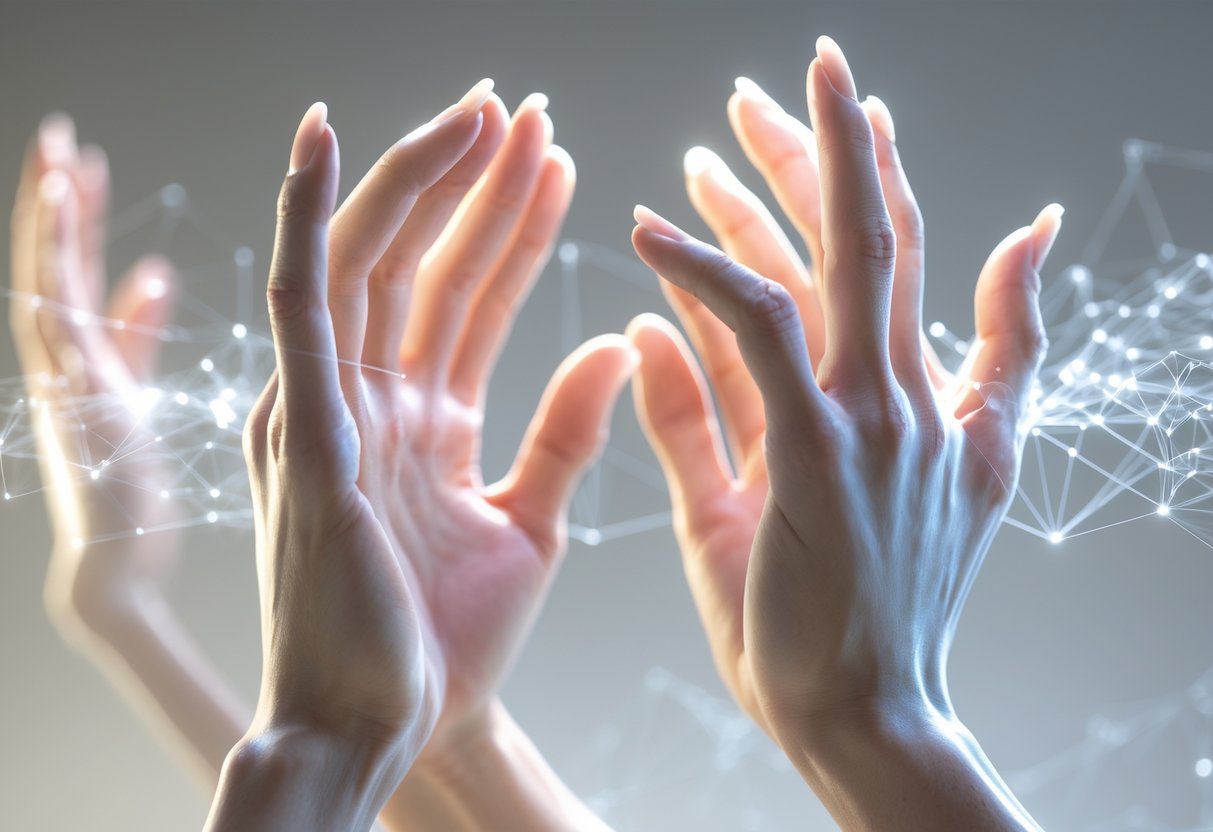
These activities blend hand movements with mental focus to build tighter brain-hand connections. They help you react faster and stay sharp during tough gaming moments.
Mirror Movements
Mirror movements train both sides of your brain to sync up. This is a big help for tricky controller or keyboard combos.
Place both hands on a table. Lift your right index finger slowly, and at the same time, lift your left index finger to match.
Try making circles with both hands going the same way. Then, switch and move them in opposite directions—it’s way tougher but really boosts coordination.
Progressive Mirror Exercises:
- Finger waves (one finger at a time, both hands)
- Thumb-to-finger touches (mirror every movement)
- Draw simple shapes in the air
- Count with gestures on both hands
Practice for 2-3 minutes before gaming. Lots of esports players swear by this as a warm-up.
Action Imitation Games
Action games challenge your brain to see, process, and react with your hands—all at once. It’s a lot like what happens in competitive matches.
Use gesture cards or online videos with specific hand moves. Watch once, then copy exactly. Start with easy stuff like a peace sign or thumbs up.
Effective Imitation Drills:
- Follow-the-leader hand patterns
- Memory sequences (watch 3 moves, repeat them)
- Speed rounds (copy faster each time)
- Multi-step combos
Gaming expert James Connolly says imitation exercises boost reaction times by teaching your brain to spot patterns faster.
Set a timer for 5 minutes and see how many gestures you can nail. This builds the quick thinking you need to stay on top in competition.
Classroom and Group Warmup Integration

Hand warmup exercises fit right into classroom routines, especially when you use brain breaks and visual poster systems. These strategies let teachers weave fine motor prep into the day so students stay interested.
Quick Brain Breaks
Hand exercises as brain breaks only take two or three minutes between lessons. Sometimes, you just pause the music and have everyone freeze, copying a hand pose on the spot.
Try out the “freeze dance” during transitions. Students dance until the music stops, then hold a pose like finger crosses or stop hands for about ten seconds.
The four corners game works well for bigger groups:
- Hang a hand exercise poster in each corner
- Kids pick a corner and mimic that movement
- The teacher picks a motion with eyes closed
- Whoever matches sits down
This game boosts working memory and fine motor skills. Indoor recess gets a little more organized when each hand signal stands for a different action.
Action sequences keep things lively:
- Fingers crossed = run in place
- Call me = squats
- Stop hands = jumping jacks
If you pick the wrong action, you sit out for a bit. That competitive spark keeps students focused and helps with coordination and motor planning.
Hand Warmup Posters
Visual posters act as handy reminders for daily hand exercises. Print and laminate four basics: fingers crossed, call me, two-hand love, and stop hands.
For remote learning, screen sharing works well. Kids just copy the movements from the posters during morning check-ins.
Set up a fine motor station by hanging posters at kid height. Switch up the combinations every week to keep things fresh.
Colouring activities add another layer. Print black-and-white versions for students to decorate, then show off their artwork around the exercise area.
Small group rotations pair nicely with posters. Each station highlights a different hand position, building finger isolation and left-right skills through repetition.
Safety Tips and Best Practices
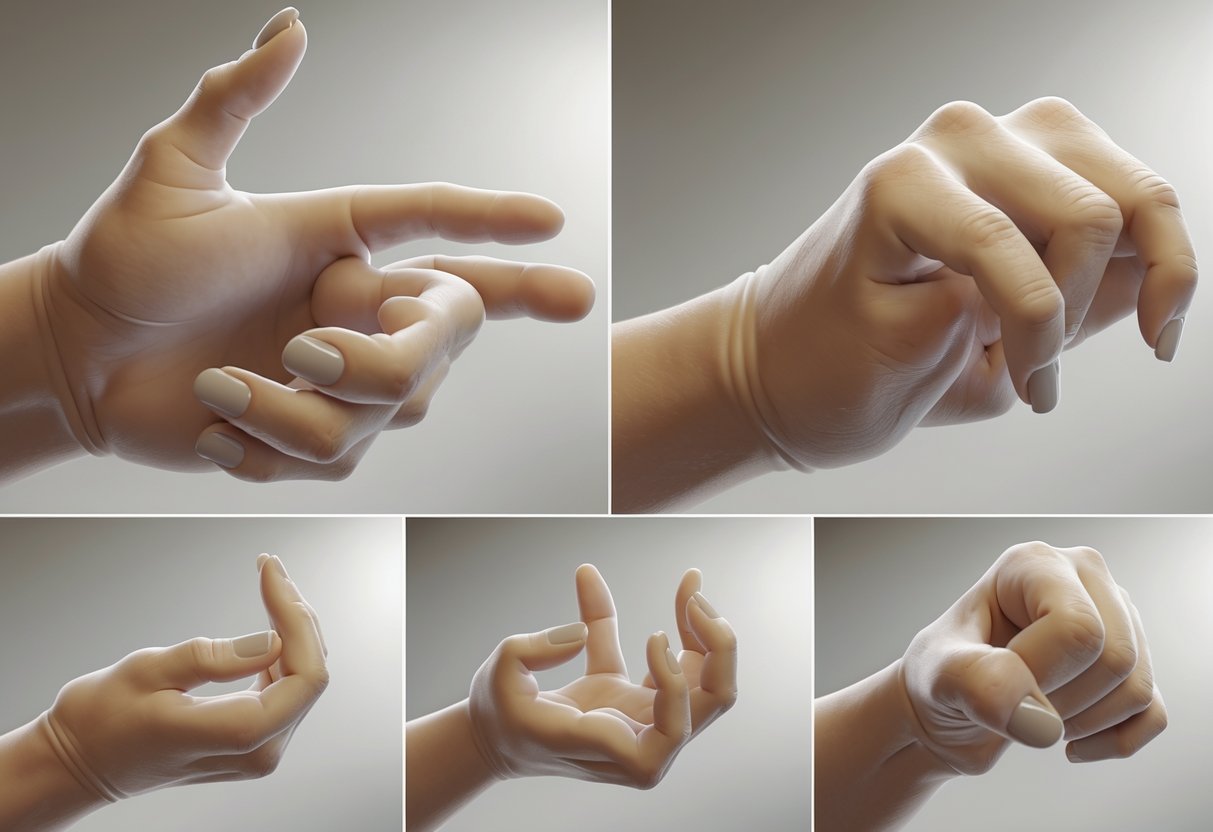
Hand warmup exercises need some attention to proper technique and limits to avoid injury. We have to notice when our hands get tired and avoid overdoing it.
Avoiding Overexertion
Start slow with any hand warmup routine. Begin with gentle moves and only ramp up intensity over a few days. Our hands have small muscles that tire out fast.
Stop immediately if you notice:
- Sharp or shooting pain
- Numbness or tingling
- Swelling in fingers or wrists
- Stiffness that gets worse
Try starting with 5-10 reps of each move. Only add more after your hands feel comfortable with the basics. Usually, this takes a week or two of steady practice.
Quick tip: Set a timer for warmup sessions. Keep them to 3-5 minutes at first.
Lots of gamers push too hard, too soon—especially with stretches and wrist rotations. These should always feel gentle, not forced.
Recognising Signs of Fatigue
Our hands show fatigue differently than big muscles. You might not get that burning feeling you notice in your legs after a run.
Early signs of fatigue:
- Slower finger moves
- Weaker grip
- Mild forearm aches
- Trouble with precise moves
Stop the exercises if you spot these signs. Pushing through can cause overuse injuries that take ages to heal.
Rest matters. Take 30-60 seconds between exercise types. Small hand muscles need those breaks.
Gaming sessions don’t go well if your hands are already tired from warming up too much. Honestly, rested hands work better than overworked ones.
Frequently Asked Questions

Here are some common questions about hand preparation for writing and gaming, plus quick warming techniques for chilly fingers.
What are some effective exercises for warming up your hands before handwriting?
Rub your palms together briskly for 10-15 seconds. That friction warms up your hands fast.
Press your palms together with fingers flat and hold for 10-20 seconds. Stretch your fingers wide, then repeat 10-15 times.
Make loose fists and then spread your fingers as wide as you can. This stretches your tendons and preps your grip for writing.
Roll your wrists in circles five times each way. It’s a quick way to loosen up your wrists and shake off stiffness.
Could you recommend some finger exercises to help with handwriting?
Touch your thumb to each fingertip, starting with your index and working to your pinky. Go back and forth 10-20 times.
Hook your fingers from both hands together and gently pull apart. Hold for 10-15 seconds to stretch those finger joints.
With fingertips touching, rotate your thumbs around each other in circles. Do 10 clockwise, then 10 counterclockwise.
Open and close your hands slowly, making a tight fist and then spreading your fingers out. This builds muscle memory for gripping pens.
What activities can I introduce to children to warm up their hands before writing?
Try clapping games or have them rub their hands like they’re warming up by a campfire. It’s fun and gets the blood moving.
Use finger puppets or counting rhymes that involve touching each finger. Kids love these and they build finger coordination.
Let them squeeze stress balls or playdough before writing. That strengthens grip and warms up the hand muscles.
Make up games where they trace shapes in the air with their fingers. It’s playful and gets those fine motor skills ready for letters.
Can you suggest some hand exercises that serve as a brain break?
Try the “finger piano”—tap each finger on the desk in order. It gets both hands moving and resets your focus.
Touch your thumb to each finger with your eyes closed. This wakes up your sense of touch and gives your eyes a break.
Do gentle stretches by interlacing your fingers and pushing your palms away from your body. Hold for 15-20 seconds.
Make slow circles with your wrists while you take deep breaths. It’s a simple combo for a quick mental reset.
What are the best techniques to prepare your hands for prolonged gaming sessions?
Soak your hands in warm water for a couple of minutes before gaming. It relaxes muscles and helps prevent stiffness.
Stretch your fingers by gently pulling each one back towards your wrist. Hold for 10 seconds per finger.
Do rapid finger taps on a table to wake up those fast-twitch muscles. It’s like a gentle version of gaming motions.
Warm up your wrists with easy rotations and flexes. Gaming can be tough on those joints, so a little prep goes a long way.
How do you quickly warm up your fingers when they’re cold?
Start by rubbing your hands together for about 15–20 seconds. That friction really heats things up fast and gets your blood moving.
If you want something even quicker, try soaking your hands in warm (not hot!) water for a few minutes. Honestly, it feels amazing and works like a charm.
Grab a warm drink or press your hands against a heat pack. That direct contact with something warm makes a big difference almost instantly.
You can also do some quick clenching exercises—just make fists and release them a bunch of times. It helps pump blood back into your fingers and brings the feeling back pretty quickly.

